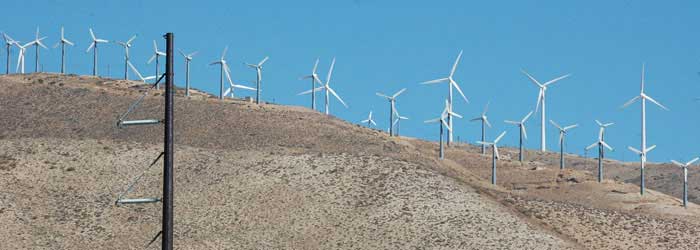
Government Scoping Meeting: Residents React to Industrial Wind Farm Proposal
January 27, 2009, Searchlight, Nevada - By LMC
How does a small rural town react when it is chosen to be the centerpiece of an industrial renewable energy project? Can a town successfully fight a large corporation backed up by the federal government when it does not want such a giant development in its backyard? We wanted to see, and since we own a parcel of land within the greater "viewshed" of the proposed wind farm, we attended the first of many public meetings hosted by the Bureau of Land Management (BLM) to "scope" comments from locals and others interested in Duke Energy's plans to place 161 large wind turbines on the outskirts of this historic mining town 40 miles south of Las Vegas (for background see >>here).
The turn-out was good. At the Searchlight community center about a hundred people gathered to hear the presentation made by the company that wants to spend $500 million to build a 370 megawatt (MW) wind energy project on public land administered by the BLM right next to the town.
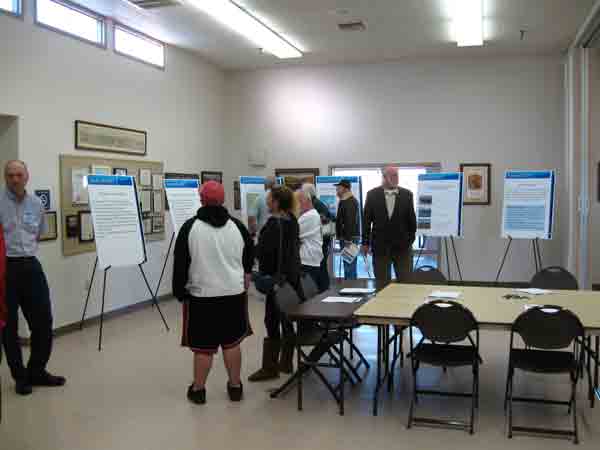
In the three hours of comments, nobody stood up and supported the project. It is a small town, with a population of about 800, and many of the residents have retired there because they like the quiet town and spectacular scenery. One woman even said that she moved there to get away from the ugly wind farm mess in Palm Springs. Everybody who spoke (about two dozen) was against the project.
The BLM hired a contractor (URS Corporation) to answer the questions, and a representative for Duke Energy was also present for questions. The BLM people were mostly quiet. The audience raised issues about property values, jobs, where money generated from the project would go, bird deaths, Joshua tree and yucca re-planting after construction, road conditions, noise and health concerns, private lands, views, and many other subjects. Many residents seemed upset and unsatisfied with the answers they received.
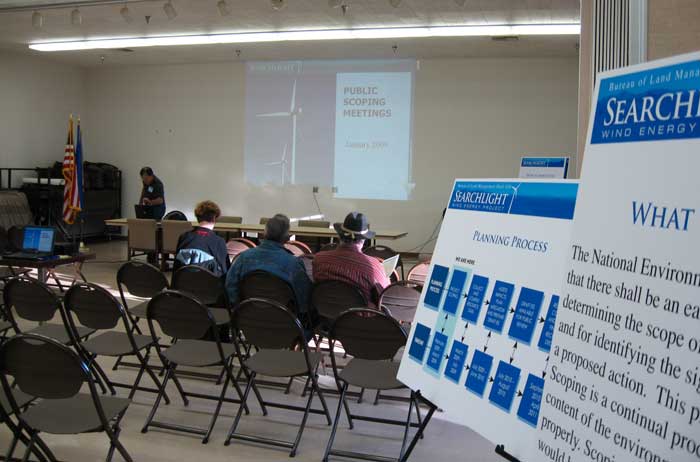
^People begin to get seated for the scoping meeting with BLM.
A Chronology of the Meeting
We took our seat waiting for the presentation to begin, and the murmurs from the audience were not positive: "How do they think this area has enough wind to turn these turbines?" asked a bearded man behind us.
"They'll have to tax gas to make this cost-effective," laughed the man in a baseball cap next to him.
Folks seemed particularly upset by the map presented in the Plan of Development, with new roads and turbines placed across several checkerboards of private land. "Hank wants 'em, Russ doesn't," continued the man behind us. He had just been arguing with one of the BLM representatives pointing to the private land on the map. "I think I got the point across to him-- this is PRIVATE LAND!" Stories arose of wind project surveyors met by a "guy with a beer in one hand and a gun in the other," telling them to stop trespassing.
Kim Liebhauser, field manager in the BLM Las Vegas office, introduced the "team" to the audience:
- The "applicant," Duke Energy, was represented by executive Robert Charlebois, a man in his 40s who looked like a herd of wild cattle kept charging at him. Duke Energy Corporation, a Fortune 500 company, is one of the largest electric power companies in the US, serving the Midwest, and is headquartered in North Carolina. In 2007 it acquired Tierra Energy, a large wind power development company located in Austin, Texas, from Energy Investors Funds for an undisclosed amount. The purchase included more than 1,000 megawatts of wind assets under development in the western and southwestern states.
- Not represented, but all-important, was the agency responsible for "getting the power from point A to point B," Western Area Power Administration (WAPA). One of four power marketing administrations within the US Department of Energy, it sells and transmits electricity from 55 hydropower plants (including nearby Hoover Dam) to utilities and public authorities. It has built several transmission lines to help connect power grids, while others were built privately. WAPA is headquartered in Denver, Colorado.
- Finally, BLM contracted a huge multinational planning and management corporation, URS, to carry out all the environmental review studies under the set of federal regulations known as the National Environmental Policy Act (NEPA). They are in the process of writing the public report that will summarize their findings, the Environmental Impact Statement (EIS). Used to, we thought, BLM personnel themselves would do this work, but so much is contracted out now to private companies, and this may be part of the "streamlining" process to jump-start renewable projects under the Obama administration. URS, too, is a Fortune 500 company. The happy, smiling young man from Idaho, Aaron English, represented them.
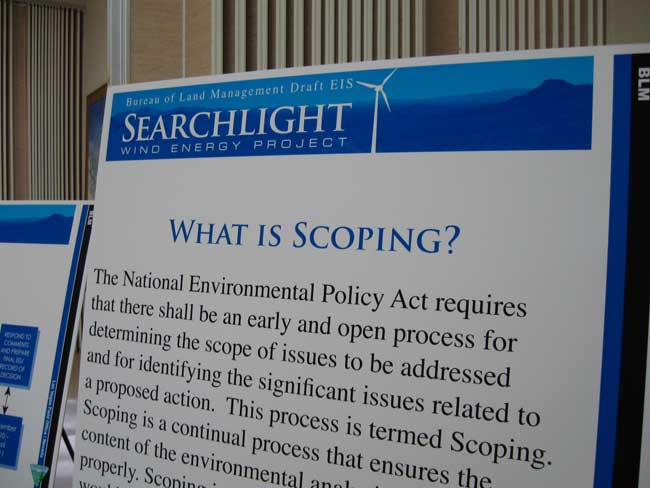
Aaron English went through his PowerPoint presentation explaining the project and the process to move it along to approval (see what the Plan says >>here). "Today we just noticed some errors in the map -- there were some turbines and transmission lines placed on private land." (Voice from the audience: "You bet it was!") English explained that the map was only a "notional map" and more information needed to be collected on wind data, mining sites, historical areas, wildlife, and "so the map may change slightly."
English went on to show how the 262-foot tall wind turbines would be connected to the 230-kilovolt Mead-Davis transmission line through substations that would be built, eventually hooking into WAPA's main powerline.
A couple of permanent meteorological stations would also be built, to collect wind speed and direction that would feed into computers. Right now, temporary "met towers" are already on site to study the wind potential. A worker restroom would be built inside a new maintenance building on site.
"We are carrying out a year of bird and bat surveys," he continued, as well as aerial photos and refined topography mapping to help place the turbines. A tortoise survey was done in winter.
Other proposed studies would include sociological and economic studies, visual studies and simulations, and noise studies for both humans and wildlife.
"Could all these studies determine this project is no good?" asked someone in the audience.
"Yes," answered English.
Someone yelled out about the El Dorado photovoltaic power plant that had just been completed 10 miles away - "They hired workers from Nicaragua after assuring us they would hire local! Will this company value the community? Pay taxes, use local labor and resources?"
Mr. English referred the question to Bob Charlebois of Duke Energy. "Duke prides itself on being a good corporate citizen." He said they are trying to understand he concerns of the community. "We want many meetings, we want to be a good neighbor, we'll be here 20 years. We'll be a fair tax payer. We want to work with the town to get money directed here. We will look into local content and we are committed to sourcing as much as we can locally." Charlebois discussed how there will be "hundreds of jobs" during construction for 6 months (later in the meeting he admitted that the number of jobs "ebbs and flows" and at times would be as low as 60 for weeks at a time). "When we are up and operating, there will be only 15 to 20 -- but good-paying!"
A man asked, "What happens after 20 years? I have two mini-turbines on my house and I can upgrade them. Why can't you upgrade?"
Charlebois explained that the "economic life" of the wind farm is typically 20 years, possibly to 30. If new technology became available their company specialists would upgrade -- "the mechanical life of the project could be longer, but I'm referring to the economic life. Wind turbines are unknown past 30 years. " He said a decommissioning fund would be established to be sure that if Duke "picks up its suitcase and runs off to Brazil" they would remove the turbines and "re-mitigate the land back to the way it was."

A woman stood up behind us and demanded, "Are you going to have a nursery? Are you going to re-seed, put back the yuccas and Joshua trees?"
Charlebois looked perplexed and deferred the question to English.
But the woman shouted, "This is unique plant life! Will you put the Joshua trees back?"
English responded, "We will restore the land."
The woman wouldn't let up. "What about the birds! North of town here they released six pairs of Black hawks. How are they gonna be safe?"
Charlebois jumped in that modern wind turbines do little harm to birds. "We have the best biologists." Whispers in the audience: "They'll kill a lot of birds."
Another woman called out, "Geese fly right over my house. We're on a flyway you know!"
We asked, "From your bird surveys, is there was an official number of bird deaths that would be considered too high to proceed with this project?"
Blank looks came from Charlebois and English. After a pause, English said, "There is no number..."
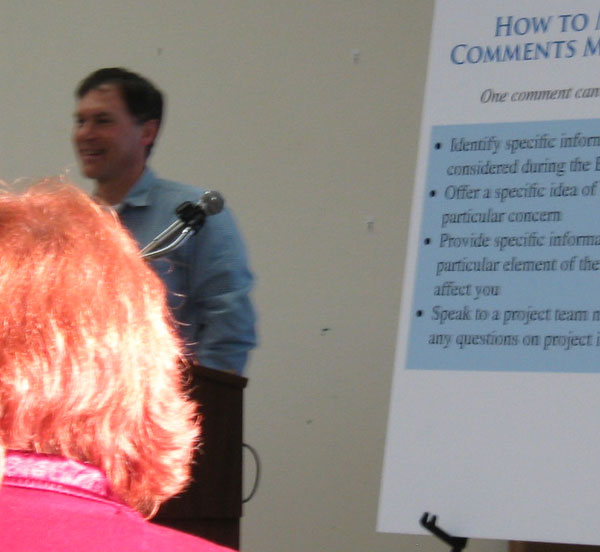
^Mr. English of URS Corp. fielded questions.
The questions moved on to noise and views, and how a "sociological study" done on the community would address these issues.
Aaron English told us how a scientific "noise model" will be done, measuring noise output from the turbines: distance, type of noise, and "key receptors" to humans and wildlife. The visual component, he added, "is more of a soft science." Surveyors would go to 4 to 6 "key BLM observation sites" where many people would see the project, and describe "color, form,and line." Charlebois joined in, "If there are important sites around town that people are particularly concerned about, we would be happy to conduct simulations," including sophisticated 3-D drive-by simulations.
Another man wanted to know about all these differing agency visual resource ratings: Nevada Department of Transportation has one, Clark County has one, and BLM has yet another one, all different. "Who trumps whom?" the man asked thoughtfully.
English replied that the BLM rating takes the lead.
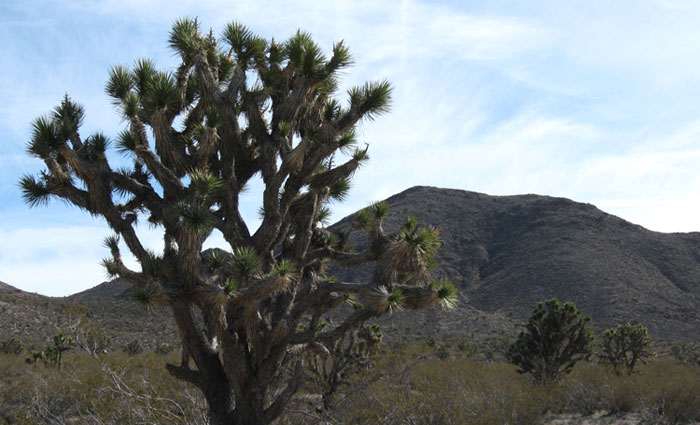
A man then asked about the concrete that would have to be delivered and poured into the turbine foundations and "a lot of heavy trucks on our local roads not designed to handle them." A 40 by 40-foot cement underground foundation will have to be built for all 160 turbines, each of which will be backfilled so that an 18-foot diameter concrete pad will be visible a few feet aboveground. The turbine tower is bolted to this.
Response from English: "An exhaustive traffic study will be done."
The man added, "will there be remediation?"
"If we break it, we fix it," Charlebois said. (The man behind us whispered, "Wasn't broke to start with.")
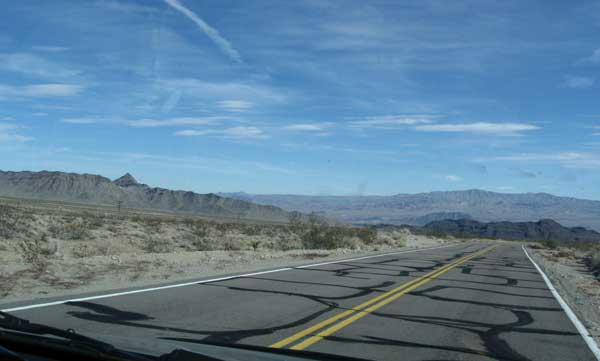
^The road from Searchlight to Lake Mead National Recreation Area that will be the main road for accessing the project hills.
Two other people wanted to know if the project would grow, will Duke fill in the land they get with more and more turbines? "Will the whole skyline be full of these awful things?" asked a woman.
Charlebois admitted that the original plan of "surrounding" Searchlight with very close turbines "was not met well by the town." He said Duke radically redesigned the locations and reduced the number of turbines. Later in the meeting he said wind was here in "commercial quantities," but having to move part of the project to the south was of some concern, because the winds there were not as good. They will need a minimum of one year of wind data to get an idea if the new positions are good enough. Someone asked if there was a minimum size of feasibility.
"That's a good question," said Charlebois Duke did not have all the information in yet to make this determination, such as which turbines to use -- 1.5 or 2.3 or even 3 MW models. Each turbine company has different technologies, and the "interconnection protocols" have not yet been made hard and fast. "We're not comfortable enough with the wind yet."
As for the question of growth, Charlebois admitted that 370 MW is the maximum they can feed into the Western line. The Western Area Power Authority determines how much electricity can be injected into the system. If Duke wanted to make this a 500 MW project, they would have to go back to square and get BLM to start a new EIS that would take 4 years. Other constraints are things such as airports, and visual resources, which, Charlebois added smiling, "you made VERY clear to us. No ambiguity that visual quality is very important to this town."
Another questioner got the answer that all turbines will have flashing lights on them at night for air safety.
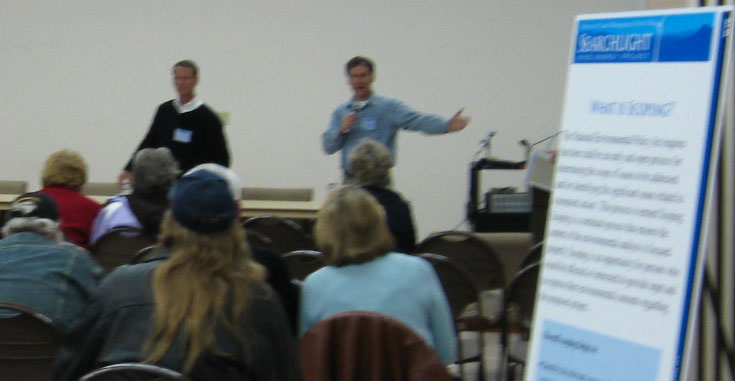
^Robert Charlebois and Aaron English answered many questions.
Another woman asked, "What about health problems? What about when people get--" Kim Liebhauser the BLM manager quickly stepped in before the woman got more emotional and encouraged her to "write down her concerns for us."
Another woman with white hair pointed out that many registered historical sites, both prehistoric and historic, lace the hills around Searchlight. "Will BLM also study the non-registered sites?"
English confirmed that BLM will look at all sites in their surveys.
Then a man asked whether the 24,383 acres of public land wanted by Duke for the project will be closed to the public? "People been goin' out there for a long time, and they like the place."
The team answered that specific areas would be closed for public safety and some roads would be changed, but access would not be cut off. The final acreage for turbines, roads, and right-of-ways would be only several hundred acres. Then the rest of the project area would be returned to BLM.
"Will each turbine be fenced?" an audience member asked.
""I don't know how to answer that," responded English.
"Yes or no!" the audience yelled.
Charlebois took over, saying something unclear about educational opportunities for kids in the future wind farm. He said Duke would do what BLM wanted them to do. He went on to explain that in their Texas wind farm hunters can walk by the turbines but in other areas this may be different.
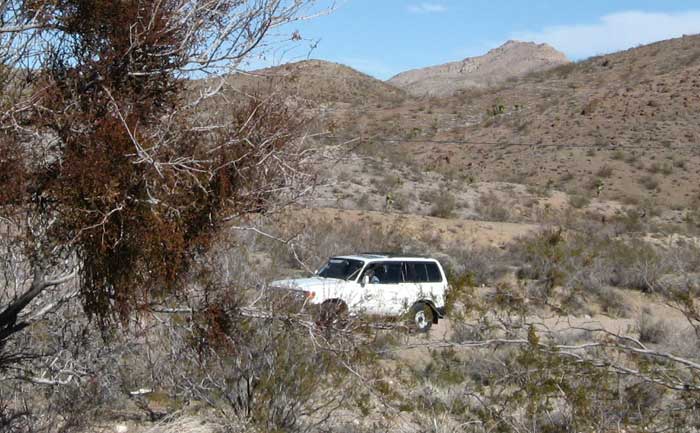
^A backroad recreationist in the hills within the proposed wind project.
"Who does this benefit?" blurted out the next questioner. Someone else in the room answered, "Duke Energy!" People laughed.
Charlebois made his speech: there is a national need to increase electric generation. There are plenty of "environmental benefits, such as no pollution." There would be an "attractive economic benefit" to the town. "Lots of folks benefit."
"Where does the energy go?" was the next question.
The Duke man said the energy will be sold to Nevada Power. ("It's all about the money," joked the guy behind us.)
"So will my electric bill be cut in half?" asked a woman. The audience laughed.
Charlebois countered, "Without getting into esoteric pricing measures, this energy will be sold at fixed price over 20 years, and will not fluctuate like the price of oil. It helps offset the volatility from fossil fuel plants."
The lady countered back, "Is Searchlight going to benefit?" The audience answered her in chorus: "No!"
"I can't sell the power to your house," said Charlebois "Electrons hit the load closest to the project, but are mixed with electrons from other areas." He and English spent some time explaining how electricity entered the grid and mixed with electricity from other sources -- locally-generated power could not be kept in Searchlight.
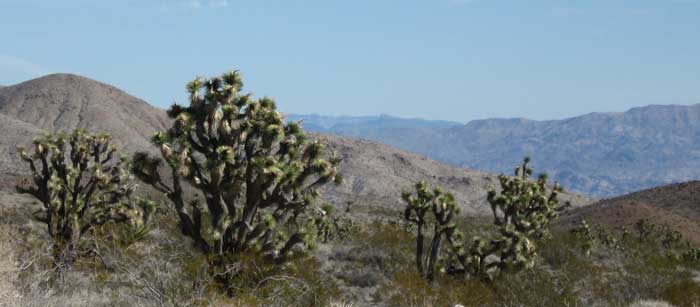
A woman holding a stalk of papers stood up and wanted to know if the majority of the community are "vehemently opposed to this, does this make a project? Who do I talk to?"
Charlebois assured the woman, that the public has a "legitimate, active, and important voice." BLM would make the decision. The audience yelled, "They didn't answer your question!"
The Liebhauser of BLM objected, "We ARE listening to you, this is a neutral process, we don't have an opinion."
"But who is THEY?" asked the woman.
"Me and Bob Ross!" said the BLM manager.
The woman in the audience said, "You don't really think our opinions do matter, do you?"
The BLM lady got mad. "I take offense to that! Duke Energy came to us! We must remain neutral by law!" She went on to explain that their decision was appealable, by going to an agency called the Department of the Interior Office of Hearings and Appeals.
Someone else asked what the monetary gain for the BLM would be from this project?
Liebhauser explained that Duke pays for BLM to do these meetings. This is a new area, not yet figured out like mining is, but she said Duke would pay royalties per megawatt to BLM, and that a schedule of costs would soon be posted on BLM's website.
"Money doesn't go into the county treasury?"
"No." But property taxes and sales taxes on equipment brought in would go to the county.
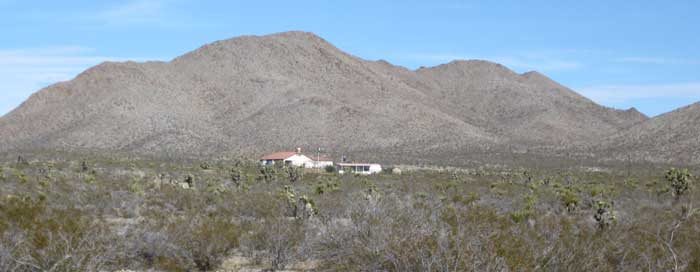
^House in Searchlight that will have its views impacted by wind turbines on the ridges.
A man then brought up property values: "What about our homes? Will our homes increase in value or decrease?"
Charlebois sighed. He explained they have "seen no credible studies" that property values decrease with wind projects nearby. "Beauty is in the eye of the beholder."
The crowd laughed loudly, with one man saying, "Oh my God!" Another: "You think seeing windmills from your house is a good thing?"
English tried to help, quoting a study done at Ellensburg, Washington, that showed no negative impacts on homeowners. In some cases wind turbines actually raised property values. The audience did not seem convinced.
Next, another man asked if wind turbines would be visible from Lake Mead (to the east of Searchlight, a popular boating area).
"Yes."
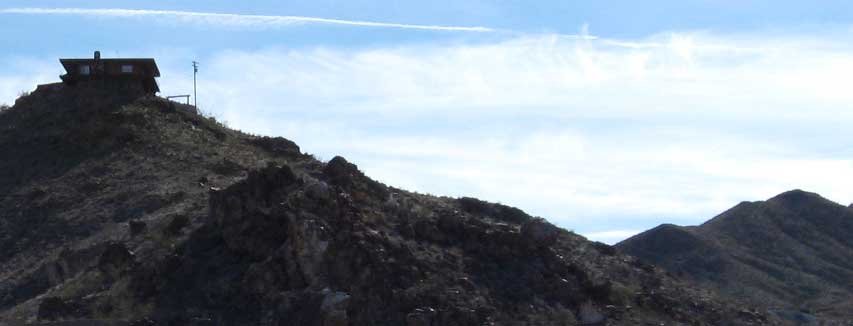
^The map shows this house will be surrounded by wind turbines.
People were beginning to leave, as the question session was going well beyond the two hours allotted for it.
"Why Searchlight?" asked an exasperated lady.
The Duke man carefully explained that after a months-long review of 8 regions in the state of Nevada, and over 20 sites, Searchlight came out as one of the top 2 to 3 sites for wind power. "Our meteorologist thinks this site is very attractive."
"Before you know it other wind companies are gonna come in, and eminent domain us, and Searchlight is no more," commented a man shaking his head.
His friend agreed. "This is the problem with Nevada -- it all goes to the federal government and gets dispersed elsewhere." The audience clapped at this statement. "We taxpayers pay BLM to pay everyone else, and it's our land!" He threw up his hands.
A gentleman with a white beard asked, "If Searchlight creates its own co-op for solar panels, we could apply for BLM land too?"
"Yes."
A woman finally said, "You ruined Palm Springs. I moved out of there to get away from all this!" she lamented.
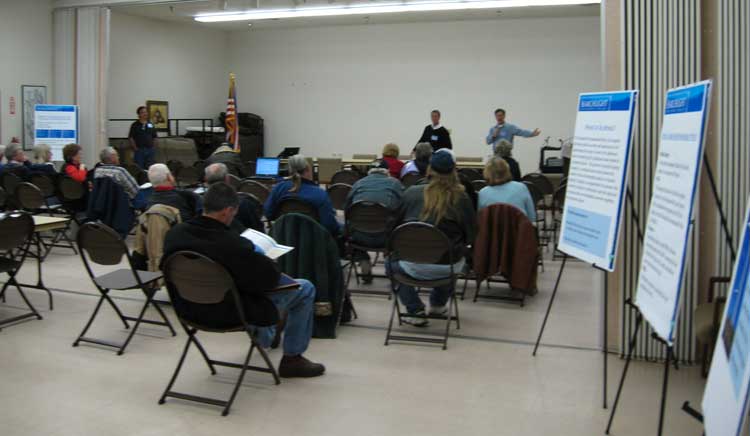
BLM-Industrial Complex
We left the meeting feeling bad for this small town in the desert. Many people here appeared to be retired, and probably had no desire to try to pull up and move away from their homes. We were impressed how well-informed the audience was about wind power issues. They like their town and its surrounding open desert with its cacti and yucca forests. They did not ask for the BLM land around them to be gobbled up for abstract national interests, for projects that will not directly benefit them. A few jobs might be available, but most of the specialized workforce will seemingly be shipped in from far away on a temporary basis, as is typical for many construction jobs in the remote desert. Will the coming renewable power building surge pit rural Americans against urban dwellers?
HOME......Searchlight Wind......Plan of Development......Solar in the Desert......Renewable News
